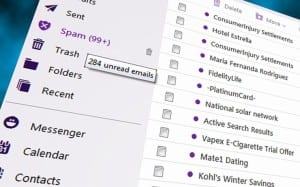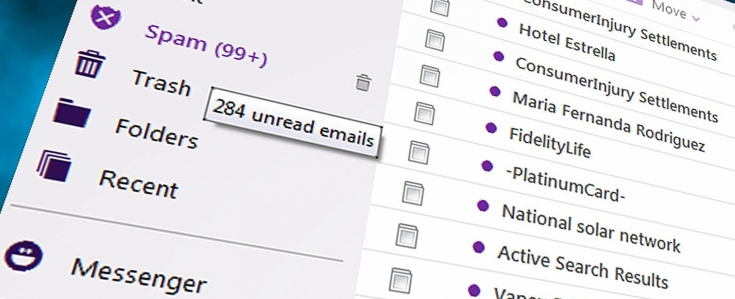The DMCA’s Spam Problem
 As a non-lawyer consultant on copyright and plagiarism matters, one of the services I provide is serving as a Digital Millennium Copyright Act (DMCA) agent for sites that accept content from third parties.
As a non-lawyer consultant on copyright and plagiarism matters, one of the services I provide is serving as a Digital Millennium Copyright Act (DMCA) agent for sites that accept content from third parties.
As I discussed previously, creating a DMCA agent is an important step for sites that accept such content to avoid liability for their actions.
This is because, while the DMCA provides “safe harbor” for web hosts (including forums, social networking sites, video streaming sites, blogging sites, etc.) it’s only available if the host meets all the requirements of the law, including designating an agent to receive and act upon notices of copyright infringement.
However, as I’ve learned, being a DMCA agent isn’t just about getting notices of infringement and working with rightsholders, it’s also about dealing with spam. Lots and lots of spam.
That’s because most of the email DMCA agents get has nothing to do with copyright infringement or other issues. Instead, it centers more around “dating” sites, pharmaceuticals and various other scams.
While this might seem to be a trivia issue, it’s grown into a serious problem for both agents and for filers alike and it’s an area where improvements could help pretty much everyone involved in the notice-and-takedown process.
Spam As An Agent
Websites, in order to ensure full compliance with the DMCA, are required to post the contact information of their DMCA agent both on their site and in the U.S. Copyright Office’s directory of agents. Theoretically, this makes it so that anyone needing to file a DMCA notice to get infringing material removed can simply look in either place to get the contact information.
When I serve as an agent, I typically create custom forwarding addresses that my clients use on their site. These addresses are either then both used in the Copyright Office registration and used on the client’s site, whether in public or behind some kind of protection.
The problem is that email addresses posted in public places tend to become targets for spammers very quickly. This is one of the reasons why many web hosts have moved to setting up special forms for reporting copyright infringement, such as at Wix and Tumblr.
Addresses that are just in the Copyright Office database are, for the most part, fairly safe. This is perhaps the one benefit of the Copyright Office’s woefully antiquated system for managing these filings. Since all of the content is stored in image-only PDFs, spammers can’t easily get at them.
But that doesn’t mean it’s impossible either. Theoretically, since most of the filings are typed, it would be trivial for a spammer (or anyone else) to use optical character recognition (OCR) software to grab the information from them. However, given that the database isn’t particularly huge by spammer standards, who usually deal in databases in the millions, it probably isn’t worth their while.
But the crux of the problem is this. If you are a DMCA agent, you have two options:
- Guard Against Spam: You can take steps to reduce spam and, in the process, make it more difficult for those seeking to file a DMCA notice or even risk losing notices in your spam traps.
- Deal with the Spam: You can deal with the spam and likely waste a significant amount of time and effort sifting through it.
For now, I’ve chosen the second option and continue to have my DMCA agent addresses bypass my spam filters. On the email addresses where there is spam, it’s not overly burdensome yet and the hassle of dealing with spam doesn’t outweigh the risk of missing a notice.
However, the volume of spam is increasing, tipping the scales away from this solution and, for many, I suspect it has long passed this point.
Spam as a Filer
While I have done and continue to do work as a DMCA agent, I also do a great deal of work filing DMCA takedown notices and shutting down infringing websites. However, on that side, spam has become an issue as well.
First is the most obvious. The use of forms by many hosts is a slow down when filing a large number of notices. Normally, DMCA notices can be sent via stock letters where only the relevant information need to be changed. However, since no two forms are the same, they have to be filled out individually and the differences can even thwart form-filling software as labels and requirements change from company to company.
But the bigger issue is the one of lost and missing missing DMCA notices. While it’s easy to say that “lost” notices are only a problem of bad companies. I’ve had several situations where companies that have been very cooperative in the past have delayed or outright lost notices I’ve sent, likely with spam filters being the problem.
The reason for this is obvious, a DMCA notice looks like a spam email. It’s a lengthy email with a slew of URLs that contains language not commonly seen in emails. By almost every metric used to measure “spamminess”, a DMCA notice fails.
This is doubly so if the notice has an attachment, which many hosts demand, and if it comes from an unusual email address, which is often the case when someone wants to track replies to notices.
In short, when it comes to DMCA notices, there is a lot of noise and not a lot of signal and the computers out there aren’t very good at distinguishing between the two. While better solutions are a long ways off, there are a few things both sides can do now to reduce the problem.
Solving the Problem
The real solutions to the problem involve changing the notice and takedown system to revise how notices are sent and received. However, in an era where the U.S. Copyright Office can’t even get the funds to upgrade their miserable DMCA agent system, any more substantial change is out of the question.
So for now it’s up to creators and web hosts to work together. While that might seem unlikely given some of the open hostilities between the two, this is an area of mutual benefit.
There are a few solutions that could help everyone involved out:
- Standardize Forms: If we need to move to using forms to prevent spam and speed up resolution, the format should be standardized in the information it collects, the order and the labels used. While anti-bot validation would still be necessary, there is no reason every site should have a completely different version of the DMCA form. That’s making extra work for hosts and confusing creators.
- Single Source Processing: Rather than every host being responsible for their own DMCA contact information, several sites and and companies can work together to share resources and create a single form/email service to handle DMCA notices to all of them. This would not only make it easier to standardize the form (as there would be only one) but it also would enable a small group to focus on the spam issue, rather than making it a part-time problem for dozens of different people and dozens of different companies. This seems especially logical since many hosts already share other resources, including datacenters, connections, servers, etc.
- Strategic Spam Filtering: Since spammers aren’t targeting DMCA agents specifically, words such as “Copyright” and “DMCA” aren’t widely used in spam emails. Whitelisting emails with those terms, in particular in the subject, could help ensure good notices go through and bad ones don’t. It is up to creators to ensure that their emails include those terms.
To be clear, none of these solutions will solve the spam problem. That problem will exist as long as DMCA notices are sent via email, but they can mitigate it and reduce the burden on both host and creator alike.
Bottom Line
Spam isn’t going away and if you do any important business via email, it’s going to be a problem. It doesn’t matter if that business is quotes to clients, legal documents from litigants or, in this case, DMCA notices.
However, this is a situation where two sides can work together to make sure that the process goes a great deal more smoothly. This, in turn, can reduce the effort for both sides by reducing the friction sending a DMCA notice and the difficulty in processing it.
Right now, no one is happy with the process and, while this won’t cure all of the woes people have, it at least removes or mitigates a few pain points.
That might not seem like much, but if you send or receive hundreds of notices per week, it can be a huge deal.
Want to Reuse or Republish this Content?
If you want to feature this article in your site, classroom or elsewhere, just let us know! We usually grant permission within 24 hours.
